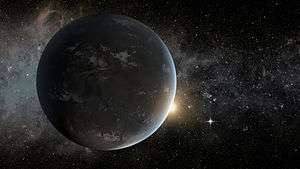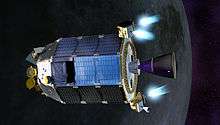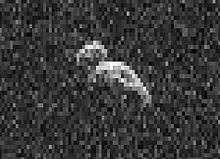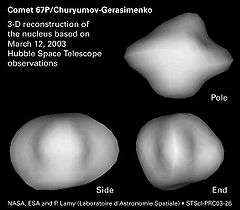C/2013 R1
 C/2013 R1 on 28 November 2013, three-minute exposure using a 6" refractor | |
| Discovery | |
|---|---|
| Discovered by |
Terry Lovejoy (Thornlands, Qld., Australia)[1] |
| Discovery date | 7 September 2013 |
| Orbital characteristics A | |
| Epoch | 14 December 2013[2] |
| Aphelion | ~800 AU (epoch 2050)[3] |
| Perihelion | 0.8118 AU (q)[2] |
| Eccentricity | 0.9984[2] |
| Orbital period |
~6,300 yr (epoch 1950) ~7,600 yr (epoch 2050)[3] |
| Inclination | 64.04°[2] |
| Last perihelion | 22 December 2013[2] |
C/2013 R1 (Lovejoy) is a long-period comet discovered on 7 September 2013 by Terry Lovejoy using a 0.2-meter (8 in) Schmidt–Cassegrain telescope.[1] It is the fourth comet discovered by Terry Lovejoy. C/2013 R1 crossed the celestial equator on 14 October 2013, becoming a better Northern Hemisphere object.
History
By 1 November 2013, the comet was visible to the naked eye near the Beehive Cluster (M44), about halfway between Jupiter and Regulus.[4] It became more impressive than comet ISON.[5] In binoculars, the comet has the appearance of a green, unresolved globular cluster.
C/2013 R1 made its closest approach to Earth on 19 November 2013 at a distance of 0.3967 AU (59,350,000 km; 36,880,000 mi),[6] and reached an apparent magnitude of about 4.5.[7] On 27 November 2013 the comet was in the constellation of Canes Venatici, near the bottom of the handle of the Big Dipper. From 28 November until 4 December 2013, the comet was in the constellation Boötes. On 1 December 2013 it passed the star Beta Boötis.[8] From 4 December until 12 December 2013, the comet was in the constellation Corona Borealis.
From 12 December until 14 January 2014, the comet was in the constellation Hercules. On 14 December 2013, it passed the star Zeta Herculis.[8] The comet came to perihelion (closest approach to the Sun) on 22 December 2013 at a distance of 0.81 AU (121,000,000 km; 75,000,000 mi) from the Sun.[2] At perihelion, the comet had an elongation of 51 degrees from the Sun. By September 2014, the comet had fainted to magnitude 18.[9]
References
- 1 2 "MPEC 2013-R72 : COMET C/2013 R1 (LOVEJOY)". IAU Minor Planet Center. 9 September 2013. Retrieved 10 November 2013. (CK13R010)
- 1 2 3 4 5 6 "MPEC 2013-V48: Observations and Orbits of Comets". IAU Minor Planet Center. 9 November 2013. Retrieved 10 November 2013.
- 1 2 Horizons output. "Barycentric Osculating Orbital Elements for Comet C/2013 R1 (Lovejoy)". Retrieved 10 November 2013. (Solution using the Solar System Barycenter and barycentric coordinates. Select Ephemeris Type:Elements and Center:@0)
- ↑ "C/2013 R1 (Lovejoy)". Gary W. Kronk's Cometography. Retrieved 10 November 2013.
- ↑ Tony Flanders (8 November 2013). "The Other Great Morning Comet". Sky & Telescope. Retrieved 10 November 2013.
- ↑ "JPL Close-Approach Data: C/2013 R1 (Lovejoy)". 8 November 2013. Retrieved 10 November 2013.
- ↑ Seiichi Yoshida (9 November 2013). "C/2013 R1 ( Lovejoy )". Seiichi Yoshida's Comet Catalog. Retrieved 10 November 2013.
- 1 2 King, Bob (29 November 2013). "Move over ISON, time to share the love with Comet Lovejoy". Astro Bob. Areavoices.com. Retrieved 29 November 2013.
- ↑ "MPEC 2014-R69 : Observations and Orbits of Comets". IAU Minor Planet Center. 2014-09-07. Retrieved 2014-09-20.
External links
![]() Media related to C/2013 R1 at Wikimedia Commons
Media related to C/2013 R1 at Wikimedia Commons
- Elements and Ephemeris for C/2013 R1 (Lovejoy) – Minor Planet Center
- Comet Lovejoy Over a Windmill (APOD : 9 December 2013)







